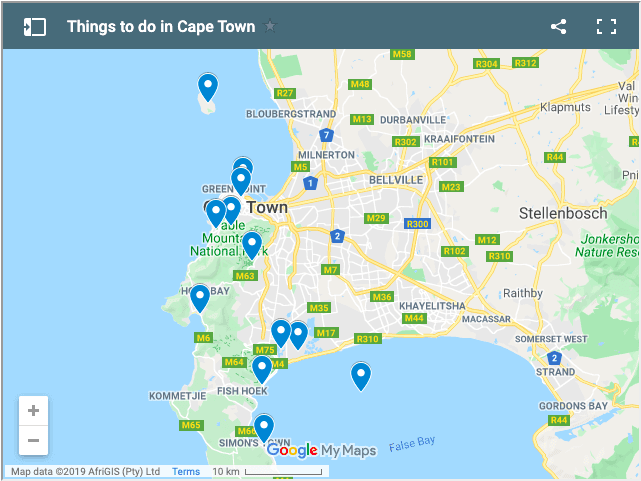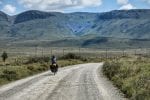Last Updated on 22 August 2024 by Cycloscope
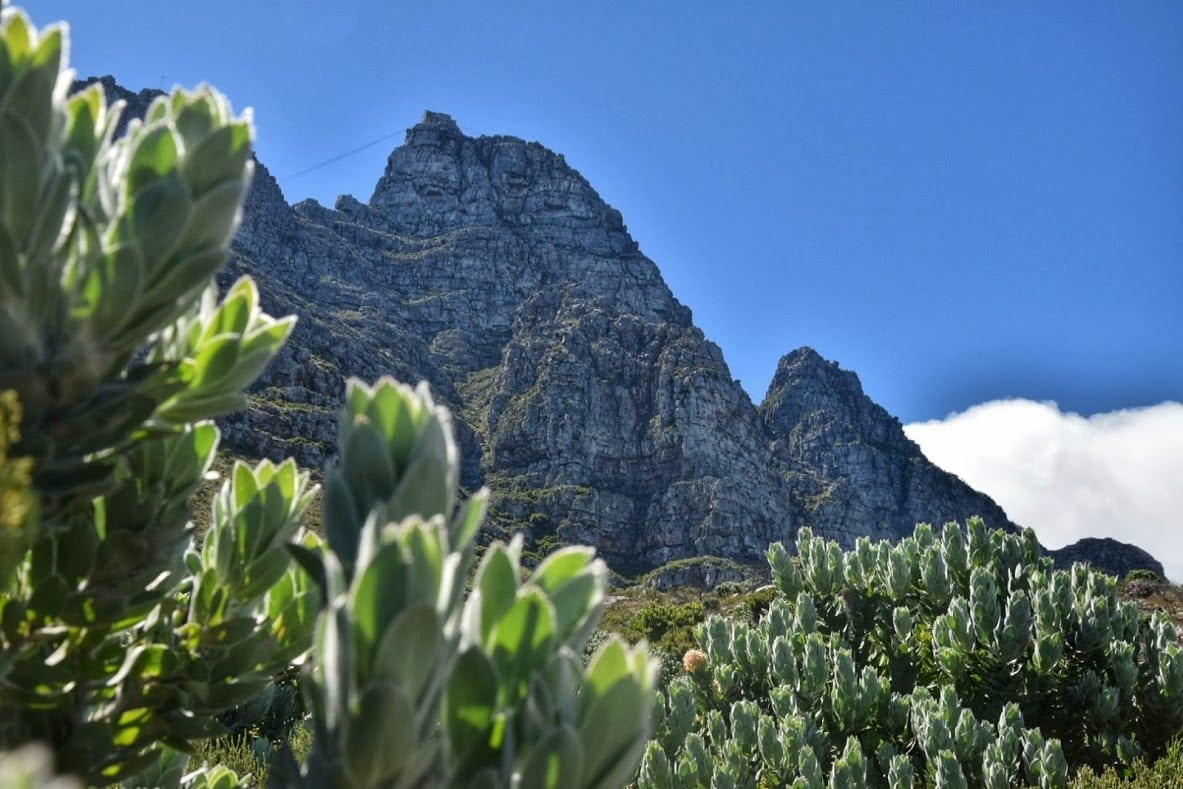
Cape Town travel blog
The best activities to do in 3 or 4 days and some hidden secrets of the most beautiful city in Africa
Cape Town is not the usual city, the feeling is more that of a series of villages tied together by a folkloristic-looking train while torn apart by the spectacular peaks of the Table Mountains. Cape Town has been one of our favorite cities ever, with its innumerable attractions and things to do and see we ended up spending 10 days here.
In this travel blog, we’ll try to give you a consistent list of the best places to visit in Cape Town in 3 or 4 days. Most people organize through tour operators, but you’ll see that’s actually not necessary.
Cape Town was our first step in Africa. We were immediately struck by it, it’s a big city, with a huge territorial extension, but completely immersed in stunning nature. What we could call the city center is Green Point, to the north, whit plenty of shopping streets, nightclubs, concerts and so on… but the best of Cape Town is not here, it is instead scattered around the rest of the wonderful peninsula, full of things to do and see.
The capital of the Western Cape province is also one of the most culturally advanced cities in Africa, with a bustling nightlife. Cape Town is also a gay-friendly city, pretty rare to find in Africa.
Suffice it to say that we met an elephant seal molding its skin on the beach of Fish Hoek, a few meters from an ice cream bar. Wildlife is literally everywhere, it’s very easy to meet the seals, penguins, and, for the bravest, to plunge into a cage and see the great white shark.
The only concern about this beautiful city is personal safety in Cape Town, in fact, this is, unfortunately, a place where you should apply caution when traveling around.
Cape Town is where our African bicycle trip started we flew here (together with our Stanforth Kibos) from Rome, with Ethiopian Airline.
Traveling South Africa? Check also
Cycling South Africa – the ultimate guide
Meeting the hippos in St. Lucia
An alternative Garden Route itinerary
Road Tripping Lesotho – Itinerary and things to know
Map of Cape Town Attractions
Cape Town, what to see in 3 or 4 days
1. Kirstenbosch Botanical Garden
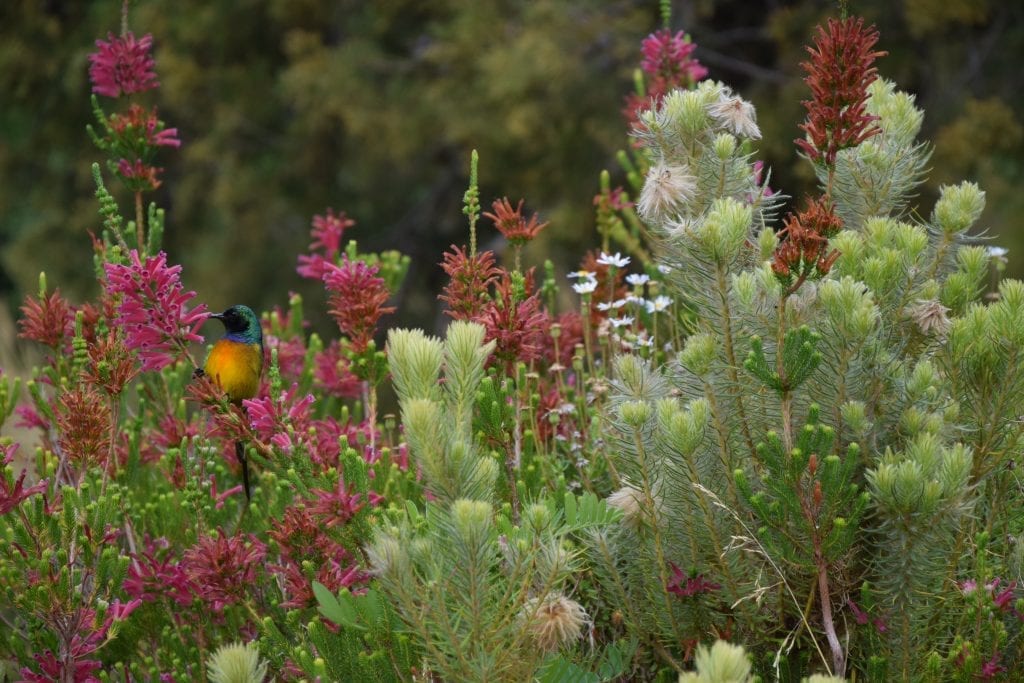
Located near the wine farms in Constantia at the foot of Table Mountain, one of the symbols of Cape Town, the Kirstenbosch Botanical Garden is a wonderful place where you can get a taste of the natural richness of this country.
It was founded in 1913 and contains plants and trees from all regions of South Africa; it is considered one of the most beautiful botanical gardens in the world, enough to be included in the list of UNESCO World Heritage sites. We have seen many around the globe and we can say that this is certainly one of those that impressed us the most.
There are areas with majestic prehistoric cycads, a garden with medicinal plants (very interesting to read all the uses, some keep dogs and even crocs away), the fragrance garden of endemic spices, and even a spectacular concert area where big shows are staged, mostly in summer.
The Kirstenbosch Botanical Garden covers an area of 530 hectares, including large biodiversity, and many species of birds, mammals, and reptiles. There are 5 main routes inside the park, all marked with precision.
At the entrance, you will be given a map of the Botanical Garden. You can climb directly on Table Mountain from the Kirstenbosch and reach the Skeleton Gorge, from where you will see a majestic view of Camp’s Bay.
Walking through the section of the Cycas you will really feel in Jurassic Park… try not to be saddened by the last specimen of an entire species, going extinct after millions of years on this Earth, just because of logging. Do not miss the national flower of South Africa, the King Protea, which can be found only in this part of the country.
How to get to the Kirstenbosch Botanical Garden
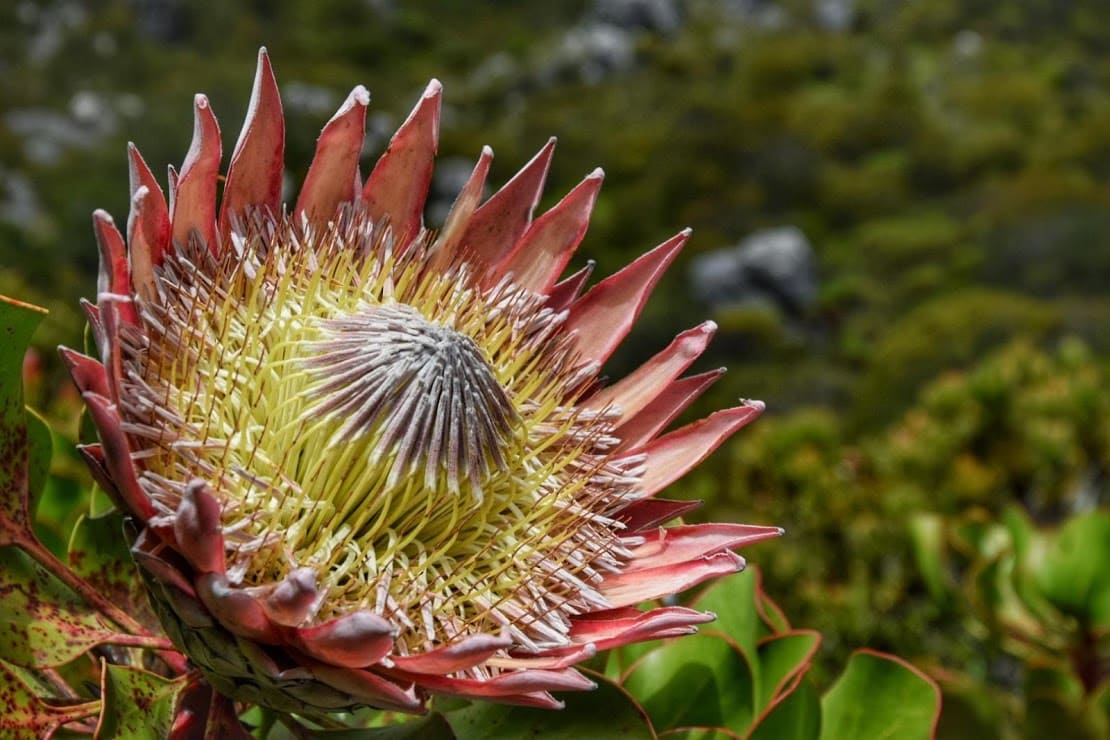
If you have rented a car you will need to take the M3 from the city center towards Muizenberg and then simply follow the signs to Kirstenbosch, the parking lot of the botanical garden is free.
For those who want to reach the park by public transport, you can take advantage of the City Sightseeing Hop-On/Hop-Off Bus (the classic double-decker tourist bus) that makes several stops along its route, more information is on the official website www.citysightseeing.co.za.
Of course, it is possible to take part in organized tours but there is really no need, moving around the city is not very difficult, and if you are on foot, just use Uber, very efficient and cheap.
Opening times:
- Summer (September – March) from 8 to 19
- Winter (April – August) from 8 to 18
- The Botanical Garden is open every day.
Entrance ticket:
- The ticket to the Kirstenbosch Botanical Garden costs 70 Rand (about 4.5 euros).
Accessibility:
- The Botanical Garden is accessible to the disabled, download this map to check accessibility points and routes. For the blind, it is possible to take the Braille Trail.
2. Hike the Table Mountain National Park
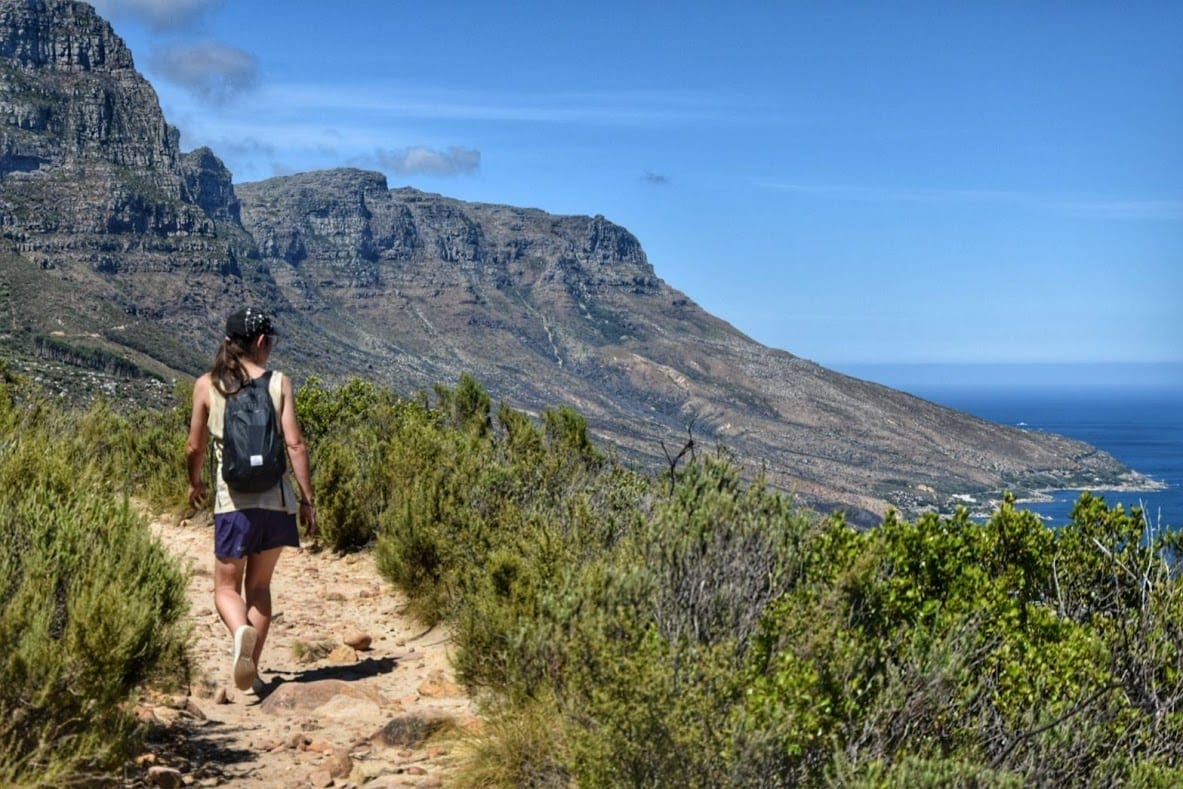
Table Mountain National Park covers an area of 221 Km², a huge wilderness area directly accessible from within the city. There are literally dozens of trails, some easy and short, some really challenging.
One of the most famous and symbolic destinations is the top of Lion’s Head, this route is famous for the landscape but also for its accessibility, it does not require much effort and is not very long. The entrance to the route is on Signal Hill Road, where the car can be parked.
If like us, you travel by bike it is always better to leave it in a safe place and reach the entrance of the footpaths in any other way, leaving bikes parked outdoors for a whole day is absolutely not recommended in Cape Town. Unfortunately, during our visit to Cape Town, the route was closed due to a fire that hit the mountain.
The hike we chose (suggested by locals) lasted about 7 hours. Entering from the north entrance of the Pipe Track, we followed it to the junction for the Kasteelport Hiking Trail that took us to the old Cable Way viewpoint.
Then we went through the Valley of the Red Gods to the Valley of Isolation where we saw several King Protea in flower, the symbol of South Africa!
Being summer the flower season was almost over but in spring there must be a real show. Indeed this is the so-called fynbos region, one of the most diverse flower ecosystems in the world.
A short description of our hike
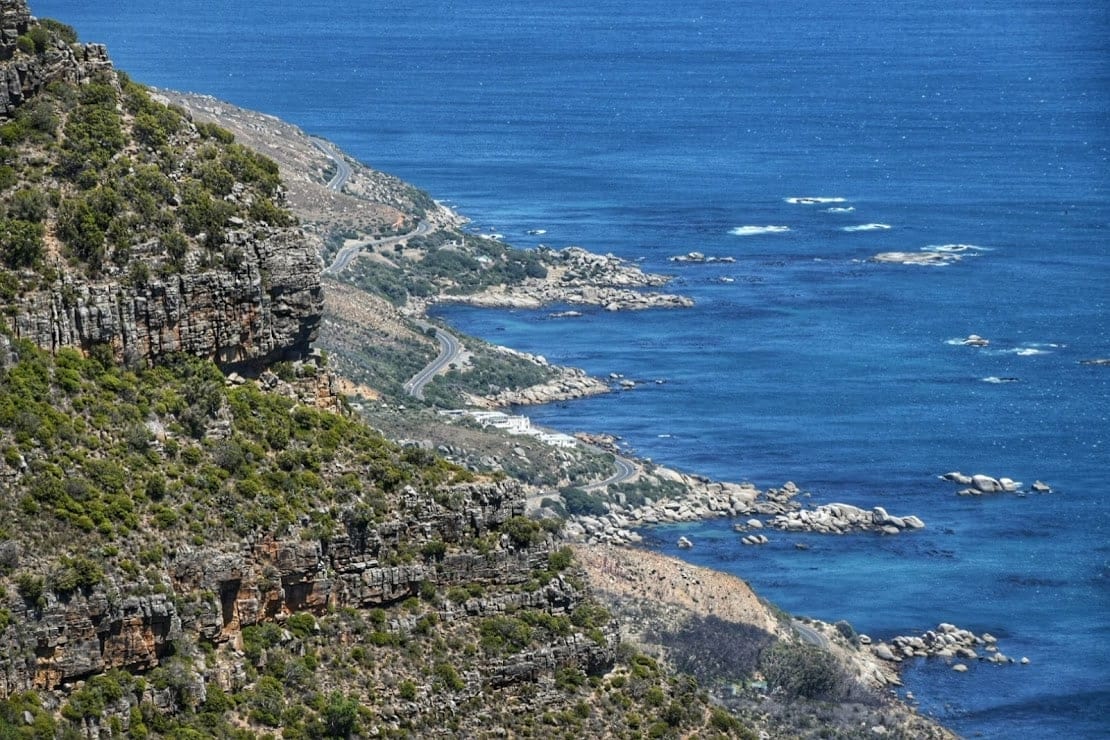
The first part of the route on Pipe Track (part of the longer Contour Trail) is rather flat, while the ascent to the top through Kasteelport is quite steep, although totally spectacular for its stunning views over unique landscapes.
Once at the top, we got to the Old Cableway viewpoint, which we didn’t enjoy that much due to the blasting gusts of wind that made us feel unsteady.
The route then led us to the Echo Valley where a few metal ladders and lousy canopies made the track a bit scary for the faint-hearted. This area though is gorgeous, you are almost at the top here with views over the entire peninsula!
Our plan was to get them to the very top at the new cable-car station, unfortunately, the ropeway was closed because of the strong wind and we had to get down on foot. The route down to the lower cableway goes through the Plattleklip Gorge, the path along this gorge is very steep and not really a pleasure when it’s windy.
You should always check online if the cableway is open or not and always consider the time needed to descend on foot. The cableway can close at any time when the wind rises.
An alternative would be to climb to the top of the Plattleklip Gorge and make the path backward. It’s a good idea to take a look at the wind forecast, which in the summer can be very strong and spoil the hike, we have downloaded an app called Windy.
If you want to go hiking for a few days, not far from the Old Cable Way there are a couple of free shelters, asking for the keys you can spend there at night, more information on this site. Camping inside the National Park is forbidden, also due to the danger of fires.
3. See the penguins at Boulders Beach
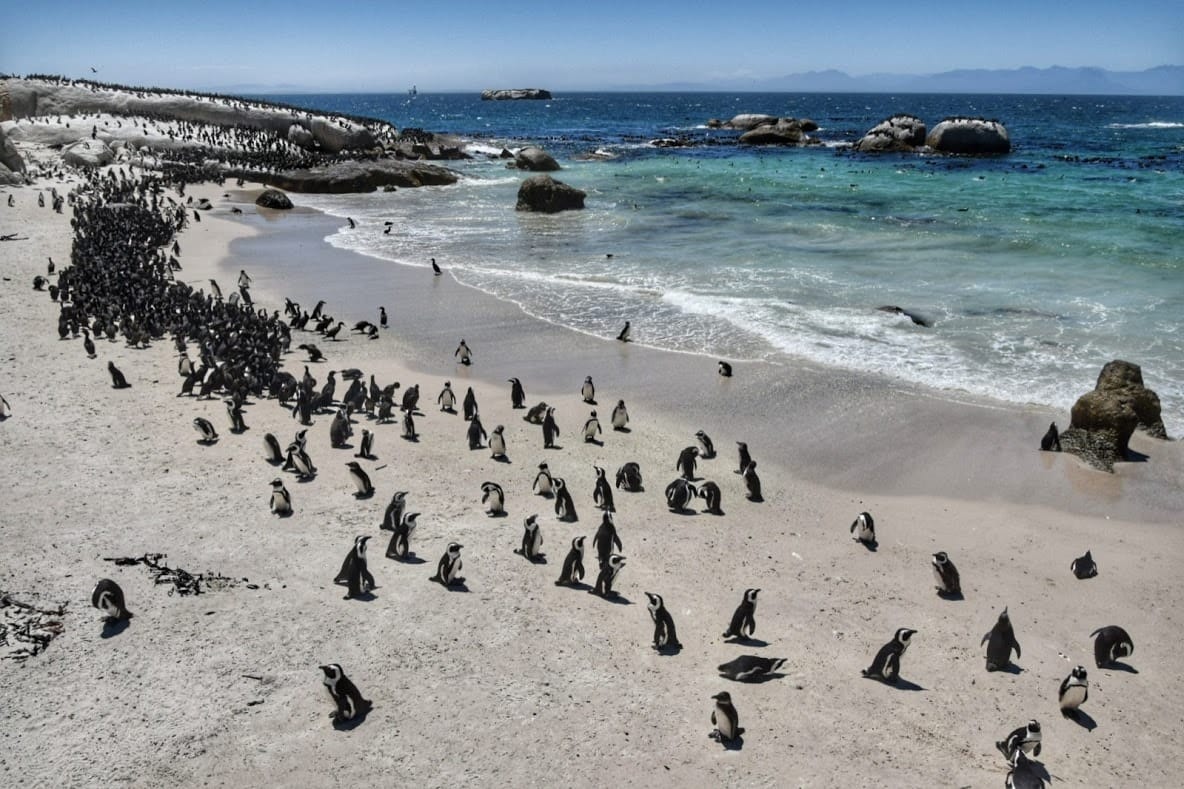
About 1 kilometer from the center of Simon’s Town, a tourist village in the south of the Cape Town peninsula, is a colony of African penguins, the only species of penguins living on the continent. Usually, in fact, penguins prefer islands to hatch eggs, in order to be more protected from predators.
The African penguins are found in the southern part of Namibia and in South Africa. They are a species at risk, in 1910 were 1.5 million, and today, due to pollution, commercial fishing, and irresponsible tourism, there are only 3000 specimens left in the colony of Boulders Beach. They are small, about 3 kilos for 60-70 centimeters in height.
The entrance ticket has just increased, it costs 152 Rand for tourists coming from other countries while there is a discounted price for South African citizens. It is the equivalent of 9.50€, which is used for the preservation of the place and the protection of penguins. If you do not want to queue at the ticket office you can buy the ticket online.
Boulder’s beach is also one of the most beautiful beaches in Cape Town, it has a dedicated swimming area where you can actually swim with penguins.
In the months of September and October, there are fewer penguins as they spend a lot of time at sea, the best season is summer, especially the month of January. We visited the colony in mid-February and there were lots of penguins.
There is another colony at Stony Point, the entrance should be cheaper and probably there be fewer tourists being away from the city.
Some locals told us that several years ago penguins were often hit by cars while crossing the nearby coastal road at night in search of food, now a fence was built for protection, keeping them away from the vehicles but also keeping the night predators far from the beach.
Entering the main entrance you will access a wooden walkway, which serves to protect the dunes and not to disturb the penguins, you will see hundreds of them, intent to hatch the eggs, raise the young, fish, and argue with cormorants, with whom they share the beach.
Going back to the entrance you can take another walkway that will take you to another vantage point, you will always be a few meters away from the penguins. Going out and continuing along the coast, always on a wooden walkway, you will arrive at the entrance to Boulders Beach (which is always accessed with the same ticket, so keep it).On this beach, protected by large boulders, the water is very calm (rare in South Africa), and if you have a wetsuit or do not fear the cold you can have a nice restorative bath and relax on the sand surrounded by penguins.
As far as we saw, they are not at all scared by humans nor even interested, obviously, you do not have to get too close, try to touch them, or do other stupid things, even if they are small, their beak is quite sharp.
If you would like to request information or support the African Penguin Conservation Center, you can contact the Boulders Visitor Center: at +27 (0) 21 786 2329.
Getting to the African penguin colony at Boulders Beach
By car, bike, or any other road vehicle, you simply have to follow the coastal road to Simon’s Town, the M4, and shortly after the village you will see the sign on your left, parking is available.
Alternatively, you can use the City Sightseeing Hop On Hop Off Bus, or take a train to Simon’s Town, the trains depart from Cape Town and cross the entire peninsula up to here, Simon’s Town is the last station.
From Simon’s Town, it takes about half an hour to walk, a pleasant walk that will also take you through the village. If you do not want to walk you can ask for a ride or call an Uber.
4. Cycling or driving the Chapman’s Peak
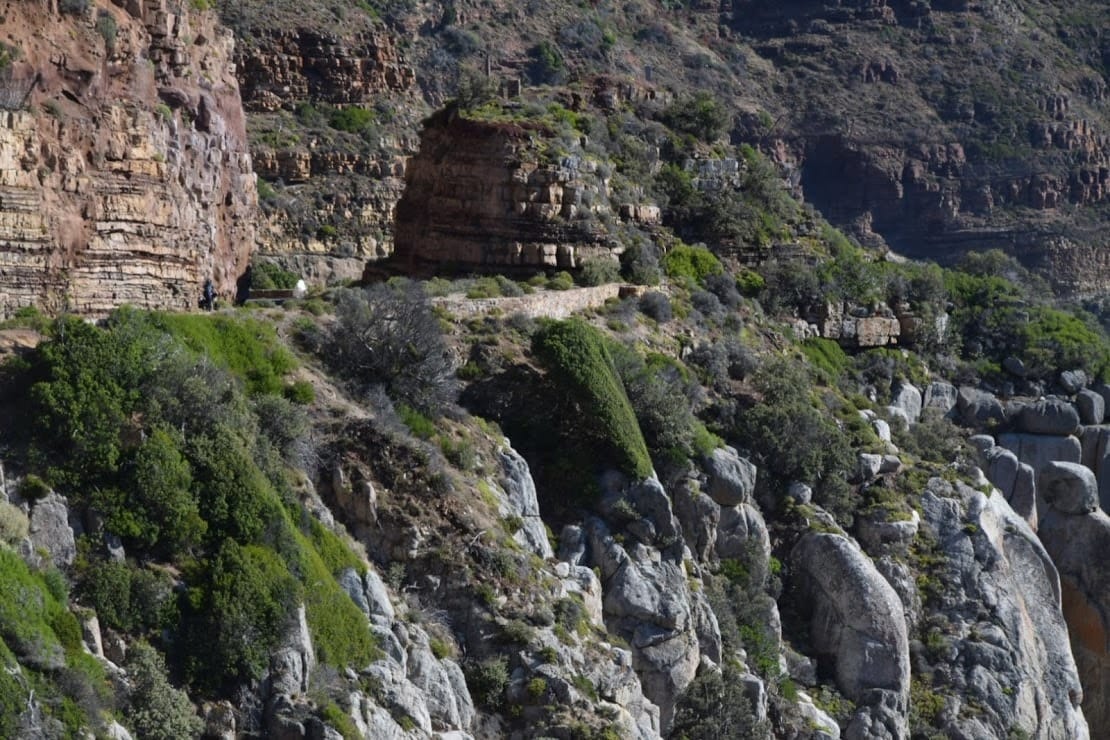
On our way from Green Point to Muizenbeg, we rode the Chapman’s Peak road, a coastline ride overlooking the sea with breathtaking scenery. This stretch of coastal road is not always open, it could be closed due to the strong wind and falling rocks. A sign indicates the state of the road before the ascent, or you can check online here, where you can also check forecasts and wind direction.
Bicycles can hit the road for free while cars and motorcycles have to pay, find the standard rates here. For those entering from Hout Bay, you can make free use of the Day Pass but this doesn’t allow you to drive the whole road, you will need to backtrack from the Day Pass Control Point. With the Day Pass, you have access to Chapmans Peak from 6 am to 8 pm from October to March and from 7 am to 6.30 pm from April to September. Check here on how to get a free Day Pass.
Along the way, there are numerous picnic rest areas with tables and sometimes public toilets. It is forbidden to camp and bicycles cannot ride after sunset.
After the pass, downhill, you will be surprised by the majesty of the beach of Noordhoek, with its dunes and white sand. a brilliant rural village, very quiet and colorful, if you want to spend the night here a list of hotels nearby.
5. Learn to kitesurf or surf in Muizenberg, Cape Town
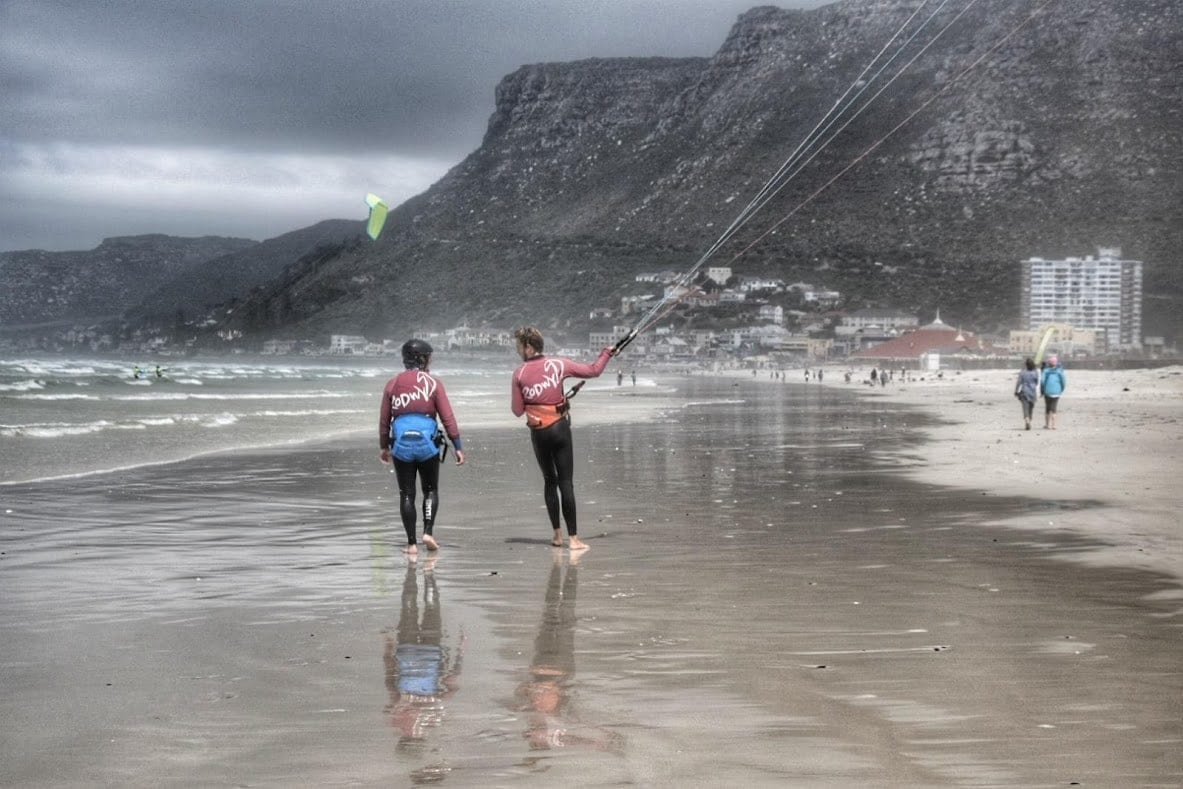
Kitesurfing (or Kiteboarding) is one of the most popular water sports in South Africa, practiced and taught almost everywhere along the country’s 2,500km coastline. In Cape Town, and in particular the Muizenberg suburb, there are several schools that can provide you with courses and individual lessons, even if you are a complete beginner.
It has always been one of my dreams so why not try to learn right here? The best time of year for kitesurfing in Cape Town is certainly the Australian summer, from November to April. The outside temperatures are high but not scorching (between 24 and 30 ° C), the water is a little ‘less frozen (about 20 ° to Muizenberg), the rainfall is rare, the skies are clear and, more importantly, the winds are constant and quite strong (35 knots).
Here’s our full article on Kitesurfing course in Cape Town.
Muizenberg is also a great spot to learn traditional surf and windsurfing, there are plenty of schools around, all with qualified instructors. If you want to relax after a day in the water, there are several nice bars and cheap fish restaurants.
Staying in Muizenberg is probably one of the best choices, have a look at how many cheap accommodations are available here!
6. See the seals at the Kalkbay pier
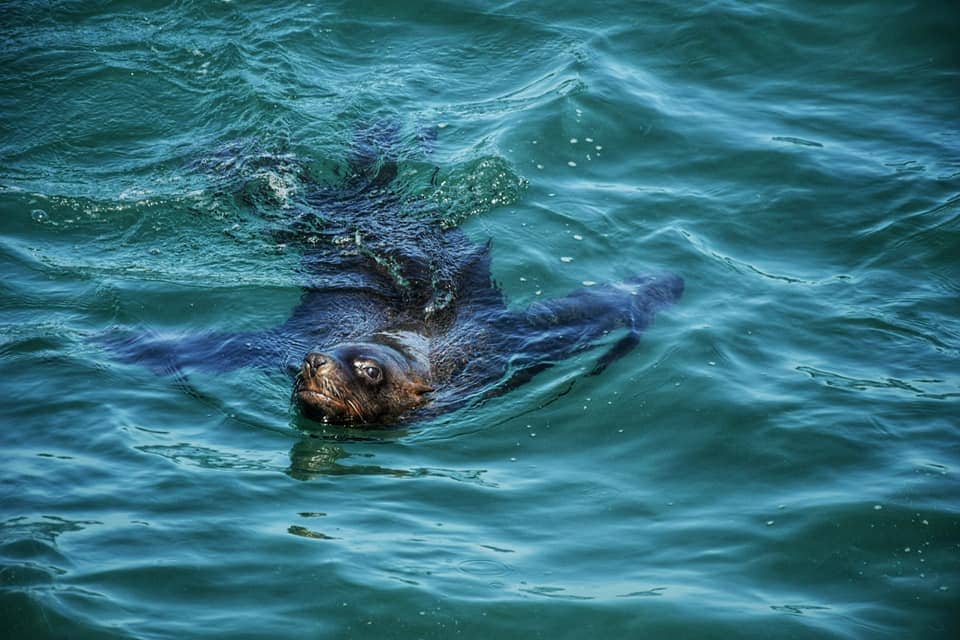
There is not much to say here, just go to the pier and the seals are there. Do not get too close, they are more agile than it seems.
Someone was feeding them when we were and there was a real show to get some food, bear in mind though that this is illegal and dangerous, don’t try to do it yourself; there will probably be some local fishermen doing it and then trying to collect a few bucks from the tourists around.
The seals usually like to swim around the docked boats or sleep under the sun in the company of fishermen. Where else can you see something like this?
7. A walk in Green Point and the V&A Waterfront – with maybe some whale-watching

It seems that the V&A Waterfront is one of the most visited places in South Africa, although honestly, we were not particularly impressed. This is technically an industrial port even if only the pier structure remains. From here there are many excursions that will take you to see Robben Island, whales, seals, and other marine attractions.
For the rest, there is a large shopping center with luxury shops, outdoor restaurants priced much higher than the rest of the city, and breweries that serve craft products. In short, we thought it was a tourist trap but if you want to spend an evening drinking (beer does not cost much) and eat and do not have a tight budget this is the place for you.
Find here the Rugby Museum (entry 75 Rand), an interactive museum with numerous digital contents that trace the history of South African national sport.
A bit further southwest is the Sea Point boardwalk, it is nothing special but we happen to see a lot of whales from there! Definitely worth passing by and trying your luck.
Green Point instead is really a nice area to stroll, home to many of the oldest buildings in Cape Town, a lot of bars, and dining options among which are some of the best vegan restaurants in the city.
8. Robben Island, the prison of Mandela… and many others
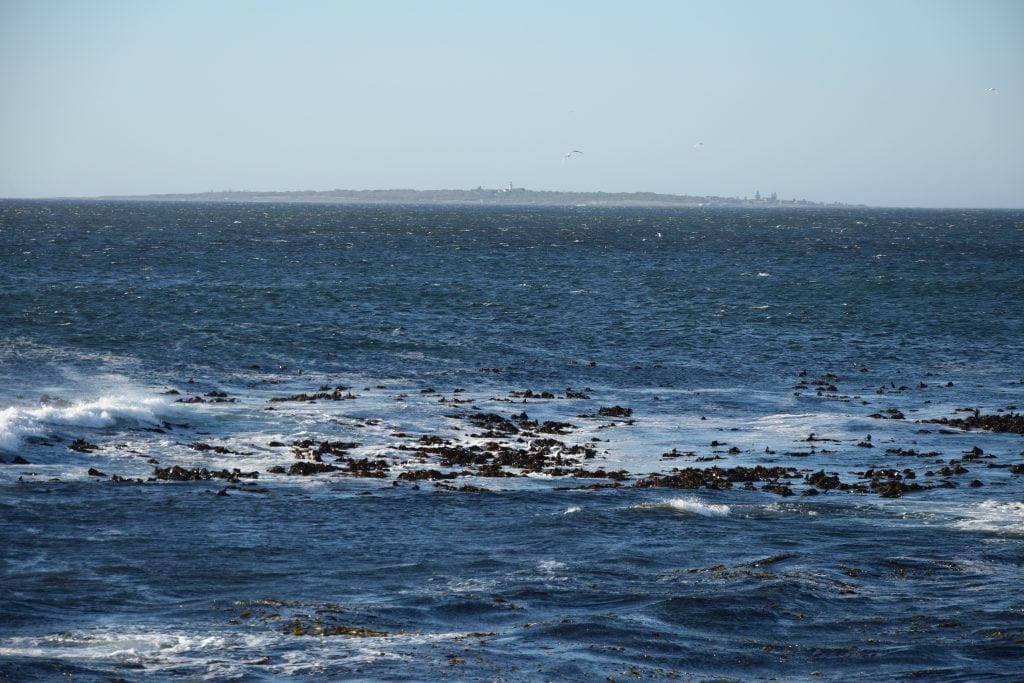
Robben Island is an island about 7 kilometers from the west coast of Cape Town, declared a World Heritage Site by UNESCO. It has an oval shape, it is only a couple of kilometers long, and is flat. Since 1600 it has been used as a political prison by the Dutch.
Nelson Mandela spent 18 of his 27 years in captivity here, every day there are three tours starting from the Waterfront, they last about 3 hours and include a visit to the Mandela cell.
In addition to Mandela, other prominent figures from the anti-apartheid and South African politics were imprisoned here as well as Kgalema Motlanthe and Jacob Zuma, the fourth South African president from 2009 to 2018.
9. A couple more things to do in Cape Town
- Swimming – Cape Town is on the Atlantic Ocean, and waters can get pretty cold and wavy. Thoughtfully though there are several seawater pools onshore, where to bathe safely. Check the one in Camps Bay, with the beautiful white sand beach and many coves around.
- Strolling the city center at Green Point – Cozy colonial architecture and loads of bars and restaurants, certainly worth spending an afternoon
- Visit Duiker Island (Sea Island) – Seal Island is home to 75,000 Cape Fur Seals and the hunting ground for the Great White Shark. Only 40 minutes from Cape Town Centre.
- Kayak or SUP board in Marina da Gama – Marina de Gama is a nice lake in the Muizenberg area, if you want to relax boating on some flat waters, that’s the place for you.
Did you find this article useful?
Do you want to see other things to see in Cape Town?
Share and contribute in the comments!


